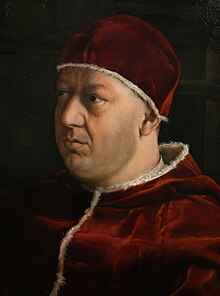
Back Pous Leo X Afrikaans ليو العاشر Arabic ليو العاشر ARZ Lleón X AST Леў X Byelorussian Леў X BE-X-OLD Лъв X Bulgarian Leon X Breton Papa Lav X BS Lleó X Catalan
Leo X | |
|---|---|
| Bishop of Rome | |
 Detail from Raphael's Portrait of Leo X | |
| Church | Catholic Church |
| Papacy began | 9 March 1513 |
| Papacy ended | 1 December 1521 |
| Predecessor | Julius II |
| Successor | Adrian VI |
| Previous post(s) |
|
| Orders | |
| Ordination | 15 March 1513 by Raffaele Sansone Riario |
| Consecration | 17 March 1513 by Raffaele Sansone Riario |
| Created cardinal |
by Innocent VIII |
| Personal details | |
| Born | Giovanni di Lorenzo de' Medici 15 December 1475 |
| Died | 1 December 1521 (aged 45) Rome, Papal States |
| Buried | Santa Maria sopra Minerva, Rome |
| Signature |  |
| Coat of arms |  |
| Other popes named Leo | |
Ordination history of Pope Leo X | |||||||||||||||||||
|---|---|---|---|---|---|---|---|---|---|---|---|---|---|---|---|---|---|---|---|
| |||||||||||||||||||
| |||||||||||||||||||
Pope Leo X (Italian: Leone X; born Giovanni di Lorenzo de' Medici, 11 December 1475 – 1 December 1521) was head of the Catholic Church and ruler of the Papal States from 9 March 1513 to his death, in December 1521.[2]
Born into the prominent political and banking Medici family of Florence, Giovanni was the second son of Lorenzo de' Medici, ruler of the Florentine Republic, and was elevated to the cardinalate in 1489. Following the death of Pope Julius II, Giovanni was elected pope after securing the backing of the younger members of the College of Cardinals. Early on in his rule he oversaw the closing sessions of the Fifth Council of the Lateran, but struggled to implement the reforms agreed. In 1517 he led a costly war that succeeded in securing his nephew Lorenzo di Piero de' Medici as Duke of Urbino, but reduced papal finances.
In Protestant circles, Leo is associated with granting indulgences for those who donated to reconstruct St. Peter's Basilica, a practice that was soon challenged by Martin Luther's 95 Theses. Leo rejected the Protestant Reformation, and his Papal bull of 1520, Exsurge Domine, condemned Luther's condemnatory stance, rendering ongoing communication difficult.
He borrowed and spent money without circumspection and was a significant patron of the arts. Under his reign, Marco Girolamo Vida began composing at the Pope's request a Virgilian Latin epic poem about the life of Jesus called the Christiad, progress was made on the rebuilding of St. Peter's Basilica, and artists such as Raphael decorated the Vatican rooms. Leo also reorganised the Roman University, and promoted Renaissance humanist study of literature, poetry, and Classics. He died in 1521 and is buried in Santa Maria sopra Minerva, Rome. He was the last pope not to have been in priestly orders at the time of his election to the papacy.
- ^ Alberigo, Giuseppe (1960). "Leone X, papa". Dizionario Biografico degli Italiani (in Italian). Vol. 2. Istituto Treccani.
- ^ Löffler 1910.